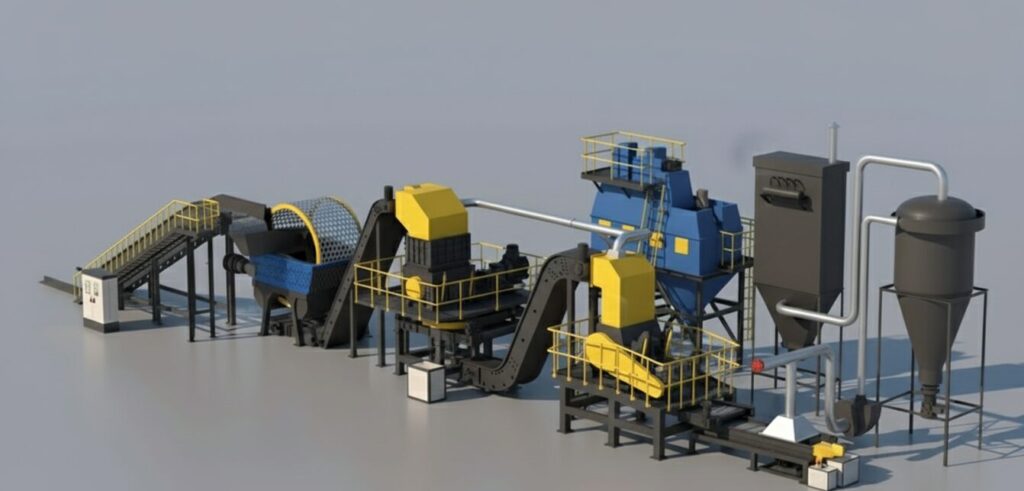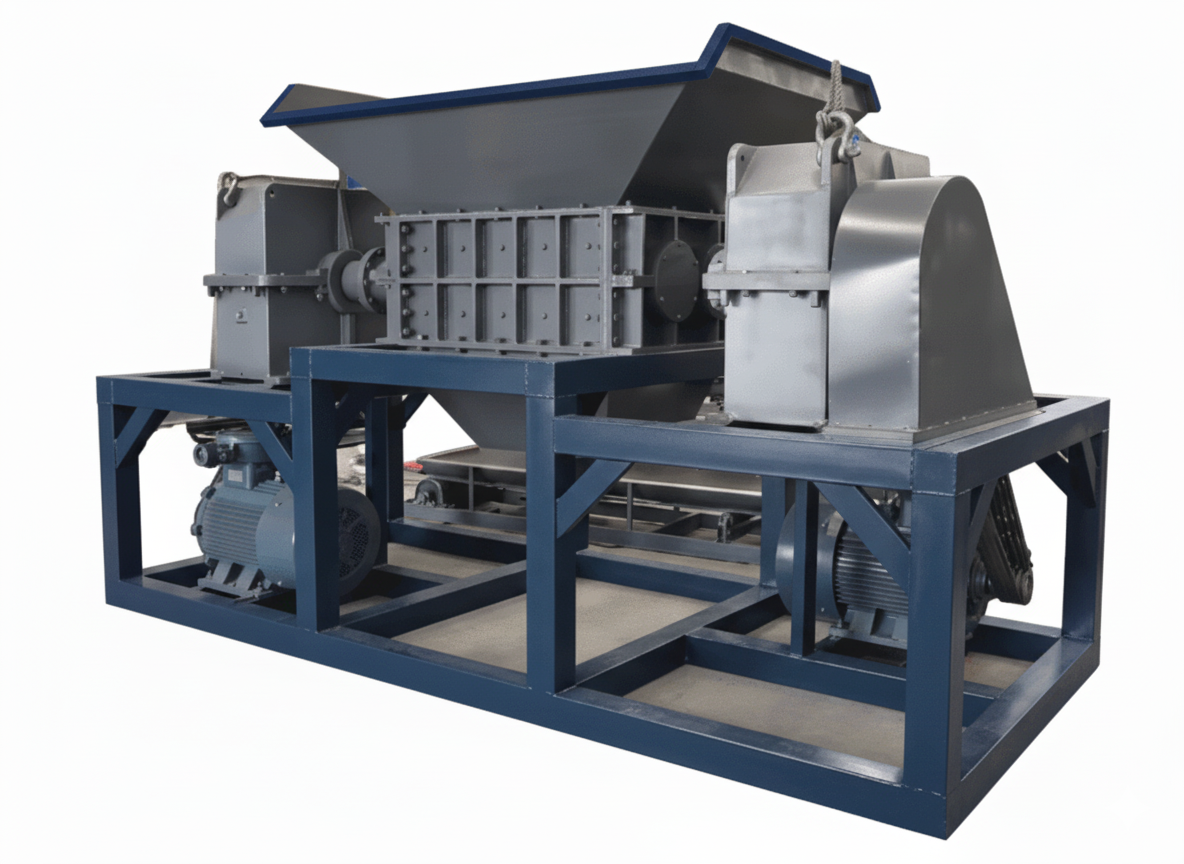
Every year, India discards about 2 million metric tonnes (MT) of tyres due to wear and tear, plus another ~0.8 million MT of scrap tyres are imported, bringing the total waste tyre burden up to 2.8 million MT annually. This rise in waste poses serious environmental and health risks—blocked drains, breeding of pests, and massive tyre dumps that can catch fire. The concept of a Waste Tyre Recycling Plant is becoming not just useful, but necessary.
What Is a Waste Tyre Recycling Plant?
A Waste Tyre Recycling Plant is a facility that takes end-of-life tyres and converts them into usable materials. These include rubber chips or crumb rubber, steel wires, fibres, and by-products like carbon black or oil (if pyrolysis is involved). Instead of burning or dumping tyres, recycling plants aim to extract value and reduce environmental harm.
👉 Contact Us Email: Info@shredall.in, Phone: +91 9090003535. Explore our Shredder range and get expert assistance.
Why India Needs Them — Market Trends & Drivers
- The tyre recycling market in India was worth USD 590.9 million in 2024, and is forecast to reach USD 743.8 million by 2030, growing at around 4.1% CAGR.
- Waste tyre imports have surged sharply—from about 2.64 lakh MT in FY21 to 13.98 lakh MT in FY24.
- Regulatory push: The Extended Producers’ Responsibility (EPR) scheme for tyres mandates producers/importers to ensure end-of-life tyres are collected and recycled properly.
Key Steps / Components in a Typical Waste Tyre Recycling Plant
- Tyre Collection & Pre-Sorting
Tyres are gathered from service stations, scrap yards, households. Sorted by size (car tyres vs truck tyres), condition, and separated from stones or mud. - Debeading & Steel Removal
Many tyres contain steel wires (in beads and belts). The steel is removed early either mechanically or via dedicated equipment so that downstream machines don’t damage. - Primary Shredding / Size Reduction
This is where shredder machines come in. ShredallTM manufactures robust tyre shredders that tear tyres into smaller chunks. A good shredder is essential here—it reduces volume, makes handling easier, and readies material for next stages. - Secondary Processing / Granulation
After shredding, rubber pieces can be ground further into crumb rubber of specified sizes. Fibre separated, steel extracted, dust controlled. - Product or By-Product Recovery
Depending on the plant’s setup, products may include:
- Crumb rubber (for playground surfaces, flooring, moulded goods)
- Rubberised asphalt or rubber mats
- Steel scrap
- Carbon black or pyrolysis oil if the plant includes thermal processes
- Crumb rubber (for playground surfaces, flooring, moulded goods)
- Environmental & Safety Controls
Plants must control dust, noise, emissions, ensure fire safety (tyres can be flammable), and manage any chemical by-products properly.
Role of ShredallTM Shredder Machines in a Waste Tyre Recycling Plant

Although ShredallTM does not build full recycling plants, its tyre shredder machines are a crucial part of many such plants. Key contributions include:
- Durable blades & dual shafts: Tyre materials are resistant—rubber layered with steel wires and fibres. ShredallTM blades are hardened and built to resist wear, making primary shredding more efficient.
- Capacity & Throughput Optimization: Shredall machines are designed to handle large batches of tyres, cutting them into manageable sizes quickly, reducing backlog at collection points.
- Safety & Maintenance: Features like blade access, stable frame, guards, and consistent performance reduce downtime and hazards.
- Facilitating Separation: By shredding tyres into smaller uniform pieces, downstream processes like magnetic steel removal, fibre separation, or granulation become more efficient and yield better output.
Benefits of Waste Tyre Recycling Plants
- Environmental Protection: Reduces tyre dumping, prevents pollutant release and fire risk.
- Resource Recovery: Steel, rubber, fibre, and sometimes oil or carbon black can be reused in other industries.
- Economic Opportunity: Job creation, new supply chains (rubber crumbs, recycled materials), revenue from by-products.
- Regulatory Compliance: Plants help businesses and manufacturers meet regulations like EPR and environmental protection standards.
Key Challenges to Address
- Ensuring proper collection and supply of waste tyres. Many tyres are stockpiled or dumped illegally.
- Ensuring that processing units—including shredders—meet safety, emission, and environmental norms. Small or informal units may operate without filters or proper safeguards.
- Managing costs: durable shredder machines, separation equipment, maintenance, labour, and environmental controls all add expense.
Conclusion
A Waste Tyre Recycling Plant is not just an environmental need—it’s a growing business opportunity. With the increasing volume of tyre waste, regulatory push, and market demand for recycled materials, the industry is set for steady growth. Shredders are a core piece of machinery in the recycling chain, and machines from ShredallTM play a vital role in enabling efficient, safe tyre recycling.
Waste Tyre Recycling Plant: Turning Scrap Tyres into Sustainable Solutions
Every year, India discards about 2 million metric tonnes (MT) of tyres due to wear and tear, plus another ~0.8 million MT of scrap tyres are imported, bringing the total waste tyre burden up to 2.8 million MT annually. This rise in waste poses serious environmental and health risks—blocked drains, breeding of pests, and massive tyre dumps that can catch fire. The concept of a Waste Tyre Recycling Plant is becoming not just useful, but necessary.
What Is a Waste Tyre Recycling Plant?
A Waste Tyre Recycling Plant is a facility that takes end-of-life tyres and converts them into usable materials. These include rubber chips or crumb rubber, steel wires, fibres, and by-products like carbon black or oil (if pyrolysis is involved). Instead of burning or dumping tyres, recycling plants aim to extract value and reduce environmental harm.
Why India Needs Them — Market Trends & Drivers
- The tyre recycling market in India was worth USD 590.9 million in 2024, and is forecast to reach USD 743.8 million by 2030, growing at around 4.1% CAGR.
- Waste tyre imports have surged sharply—from about 2.64 lakh MT in FY21 to 13.98 lakh MT in FY24.
- Regulatory push: The Extended Producers’ Responsibility (EPR) scheme for tyres mandates producers/importers to ensure end-of-life tyres are collected and recycled properly.
Key Steps / Components in a Typical Waste Tyre Recycling Plant
- Tyre Collection & Pre-Sorting
Tyres are gathered from service stations, scrap yards, households. Sorted by size (car tyres vs truck tyres), condition, and separated from stones or mud. - Debeading & Steel Removal
Many tyres contain steel wires (in beads and belts). The steel is removed early either mechanically or via dedicated equipment so that downstream machines don’t damage. - Primary Shredding / Size Reduction
This is where shredder machines come in. ShredallTM manufactures robust tyre shredders that tear tyres into smaller chunks. A good shredder is essential here—it reduces volume, makes handling easier, and readies material for next stages. - Secondary Processing / Granulation
After shredding, rubber pieces can be ground further into crumb rubber of specified sizes. Fibre separated, steel extracted, dust controlled. - Product or By-Product Recovery
Depending on the plant’s setup, products may include:
- Crumb rubber (for playground surfaces, flooring, moulded goods)
- Rubberised asphalt or rubber mats
- Steel scrap
- Carbon black or pyrolysis oil if the plant includes thermal processes
- Crumb rubber (for playground surfaces, flooring, moulded goods)
- Environmental & Safety Controls
Plants must control dust, noise, emissions, ensure fire safety (tyres can be flammable), and manage any chemical by-products properly.
Role of ShredallTM Shredder Machines in a Waste Tyre Recycling Plant
Although ShredallTM does not build full recycling plants, its tyre shredder machines are a crucial part of many such plants. Key contributions include:
- Durable blades & dual shafts: Tyre materials are resistant—rubber layered with steel wires and fibres. ShredallTM blades are hardened and built to resist wear, making primary shredding more efficient.
- Capacity & Throughput Optimization: Shredall machines are designed to handle large batches of tyres, cutting them into manageable sizes quickly, reducing backlog at collection points.
- Safety & Maintenance: Features like blade access, stable frame, guards, and consistent performance reduce downtime and hazards.
- Facilitating Separation: By shredding tyres into smaller uniform pieces, downstream processes like magnetic steel removal, fibre separation, or granulation become more efficient and yield better output.
Benefits of Waste Tyre Recycling Plants
- Environmental Protection: Reduces tyre dumping, prevents pollutant release and fire risk.
- Resource Recovery: Steel, rubber, fibre, and sometimes oil or carbon black can be reused in other industries.
- Economic Opportunity: Job creation, new supply chains (rubber crumbs, recycled materials), revenue from by-products.
- Regulatory Compliance: Plants help businesses and manufacturers meet regulations like EPR and environmental protection standards.
Key Challenges to Address
- Ensuring proper collection and supply of waste tyres. Many tyres are stockpiled or dumped illegally.
- Ensuring that processing units—including shredders—meet safety, emission, and environmental norms. Small or informal units may operate without filters or proper safeguards.
- Managing costs: durable shredder machines, separation equipment, maintenance, labour, and environmental controls all add expense.
Conclusion
A Waste Tyre Recycling Plant is not just an environmental need—it’s a growing business opportunity. With the increasing volume of tyre waste, regulatory push, and market demand for recycled materials, the industry is set for steady growth. Shredders are a core piece of machinery in the recycling chain, and machines from ShredallTM play a vital role in enabling efficient, safe tyre recycling.

